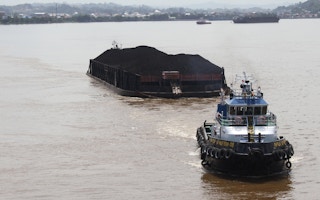The Indonesian government’s controversial plan to move the nation’s capital from Jakarta to Borneo has hit one of several snags that critics have long warned about: the presence of thousands of abandoned coal-mining pits at the site of the new city.
The environment minister, Siti Nurbaya Bakar, revealed the scale of the problem during a parliamentary hearing on March 28, where she said the site in East Kalimantan province is pocked with 2,415 of these pits, covering a combined area of 29,000 hectares (71,700 acres).
The region is known as Indonesia’s coal-mining heartland; around 40 per cent of East Kalimantan’s total land area is earmarked for coal concessions.
Siti said her ministry had begun rehabilitating some of these abandoned pits in 2021.
“We have monitored, tried to check and carried out trials to rehabilitate [the open pits],” she told lawmakers.
“
The mining pits should be reclaimed and closed. When they’re not closed, they will endanger nearby locals.
Pradarma Rupang, chapter head, Jatam East Kalimantan
The revelation has sparked a chorus of “I told you so’s” by activists who have questioned the feasibility of the relocation plan since it was announced by President Joko Widodo in 2019. Among them is the Mining Advocacy Network (Jatam), a watchdog NGO that has long campaigned about the dangers of abandoned mining pits and called for the companies responsible to be held responsible.
Pradarma Rupang, head of Jatam’s East Kalimantan chapter, questioned why the government — and, by extension, the Indonesian public — should pay for rehabilitating the pits. By law, coal companies are required to clean up the damage they leave behind, filling in mining pits that are no longer in use and revegetating or restoring mining sites.
However, many companies often flout this responsibility, leaving behind gaping holes that eventually fill with rainwater to create “pit lakes.” In the case of the new capital, called Nusantara, it appears the public has been left holding the bag, Pradarma said.
“This becomes an escape route for miners to evade their responsibility [to rehabilitate and close mining pits],” he said as quoted by local media. “This is whitewashing a sin because it’s the state that’s taking over the responsibility for the recovery.”
The energy and mining ministry, which is responsible for ensuring that companies rehabilitate their decommissioned mines, has denied that the rehabilitation at the Nusantara site will be paid for by the state.
Sony Hery Prasetyo, head of the ministry’s coal and mineral information working group, said rehabilitation is the responsibility of miners who hold the concessions, as stipulated in the 2020 mining law, and that there are no exceptions. However, he didn’t say how the Nusantara rehabilitation will be paid for, or why there were abandoned pits there in the first place if indeed there were no exceptions to the requirement that coal companies rehabilitate their sites.
The government’s proposed solutions for dealing with the pit lakes have also been panned. Environment minister Siti said they could either be turned into swamp forests, serving as wildlife habitat; or developed as agritourism sites, where visitors pay to fish in the rainwater-filled pits; or else used as a source of fresh water for the residents of the new capital.
Pradarma warned that as long as the pit lakes were not filled in with earth, none of those options could be considered safe.
“The mining pits should be reclaimed and closed,” he said. “When they’re not closed, they will endanger nearby locals.”
Between 2011 and 2021, at least 40 people, 33 of them children, died from drowning in pit lakes, according to Jatam’s data.
“There will be new victims from these mining pits, such as children drowning,” Pradarma said.
There’s also the question of using the pit lakes as a source of fresh water, a point on which Siti contradicted herself.
She initially told parliament that “these former mines that are flooded with water should be able to be used as water source for the new capital.”
But she then later pointed out that the water, often a startling shade of turquoise due to reactions with the various elements unearthed alongside coal, would be far too acidic for human use. According to Siti, the pH level in pit lakes can go as low as 2.6 — making the water much more acidic than acid rain, or about as strong as stomach acid.
The notion that Indonesia’s new capital city would have to rely on these acidic pools for its water points to another common criticism of the relocation plan: the fact that fresh water is scarce at the Nusantara site.
This was confirmed by Sigit Reliantoro, the enviroment ministry’s director-general for environmental degradation and pollution mitigation. Speaking at the same parliamentary hearing, he said the new strategic environmental assessment for the project has revealed a lack of groundwater in the location of the new capital.
Sigit said the government has already built a reservoir in the neighboring district of North Penajam Paser to supply water to the new capital, and plans to build “two or three more” to serve the city.
This story was published with permission from Mongabay.com.








